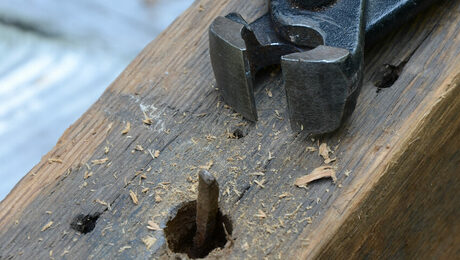Flattening an extremely warped board on the jointer
In this video, Bob Van Dyke shows you how he flattens a board that many would consider too warped to useFlattening boards on the jointer is usually a straightforward process, but sometimes extremely warped or twisted boards can present a challenge. According to Bob Van Dyke, the problem comes when the normal process for flattening–which involves changing where you’re placing pressure on a board as it moves over the cutter head–leads to a cut that follows the twist instead of removing it. Bob’s solution is to place a single patten in the center of the board and use it to pass the entire board over the cutter head without ever changing where he applies pressure. He’s also sure to split the difference in the warp, balancing the board off of two corners at the beginning instead of three, to ensure he doesn’t end up with one very thin corner by the end of the flattening process.























Comments
Nice. I've always done the pressure on the lead end thing, and it takes about 10 passes. This is very helpful. Thank you.
Great Tip! Saves a lot of time & labor
Thanks
cut it shorter,joint it,save thickness.Call it a 3FT rule For 4 qtr. I have jointed thousands of brd ft using this method.13/16th plus results.
Would you go on to edge jointing at that point? This makes me think I'm wasting a lot of time face jointing the entire surface.
Great tip. I learned from an old timer an addition to this method. With a couple pinches of sawdust, build a small pad at the front and back of the board to hold it to about half the warp depth. That way you won't wobble the board through the jointer. The sawdust won't harm the blades and you get a way to hold the board still.
That is more work than the board is worth... Glue sacrificial
strips to the board's edger that are wider that the board's thickness plus the gap between the board's bottom surface and the top surface of the bench and run it through the thickness planer. Once you have a flat surface turn it over and surface the other side. Both methods will reduce the thickness. And the thickness planer is far more safer than using the jointer.
Not sure I understand your point. What Bob showed takes no more time than jointing a standard board - just a different way to position the board. Cutting strips, gluing and clamping, then planing would take far longer. Then you would have to potentially edge joint the boards to remove the glued strips. Based on your comment, your method is a great idea for using a planer without a sled, and is safer than using a jointer but takes a far longer time. I must be misunderstanding something here since you think this process is far faster? In any case, I have not tried your planer method so will give it a go for longer boards. Thanks USAChief for the idea.
As a user of hand planes only, it's interesting to see how a little bit of manual dexterity and "feel" can also be applied to a stationary jointer.
Thanks for this. There's one thing I'm wondering about. Since I don't have a thickness planer, how could I flatten the other side of the board so it is parallel to the first face I flattened?
There is not easy answer to that question. That is the sole purpose of a planer. Hand tools are about the only option without one.
user4234885- you can't very accurately. Perhaps with a good band saw you could resaw accurately enough to run the other side through the jointer. Most wood suppliers such as Woodworker's Source allow you to pick your boards according to the quality you can work with.
Just restack in a neat stack.
To get the maximum thickness, you must split the difference of the front and back gap: slide a wedge under the backside low corner til it matches the front low corner. Keep the wedge-shim in place by keeping pressure on the back end, or use some superglue, hot melt. Once you've established a flat face on the front and back low corners, keep pressure on those corners as subsequent passes flatten the whole face. I don't think what's shown in this video will work, since there's too much wobble in this freehand method.
Tom K. If a jointer is the only way you have to flatten one side, then your method the one to use. I am really surprised that Fine Woodworking would suggest even attempting this. Even with push blocks, should the board rock and twist, loss of control can prove disastrous.. My left thumb is 3/8" shorter because of something too similar to this. Even the piles of sawdust are better than relying on NOT rocking the board. An accident waiting to happen.
I don't think there is any reason to doubt Bob here. I've been using this method for years. It works well and is not dangerous. His hands were no where near the blades and the board was not rocking.
Sacrificial edge boards glued on and send it thru the planer--no muss ,no fuss, no danger, and works perfect EVERY time!
A good tip. Simple and easy to understand. This is much quicker than other methods.
Funny how the best ideas are usually the simplest. I've tried all the other methods, including the planer tricks, but this seemed so counter intuitive, didn't make sense until I saw the video.
Thanks Bob Van Dyke. Guys like you are the reason I've read Fine Woodworking for the past 40 years.
I use a few passes with a hand plane set for a heavy cut to knock off the high points at the corners. It is pretty fast and I don't have to worry about rocking.
I like the idea of hot melt to glue spacers on the low corners. I've used the sacrificial side rails idea to flatten boards much wider than my jointer.
Plenty of good info in these tips, in addition to the video. I'll give some of them a try. Thanks for the tips, contributors.
I hadn't thought of only using the pad in the center before, but have been doing the same thing splitting the difference. After the first pass or two, the board is stable. I also like the idea of shimming with some sawdust or gluing on a small shim, but that only works if the board is all on the infeed table. Holding the angle with a push pad is fast and works well. As long as you are using good pads, I see no reckless danger here.
Log in or create an account to post a comment.
Sign up Log in